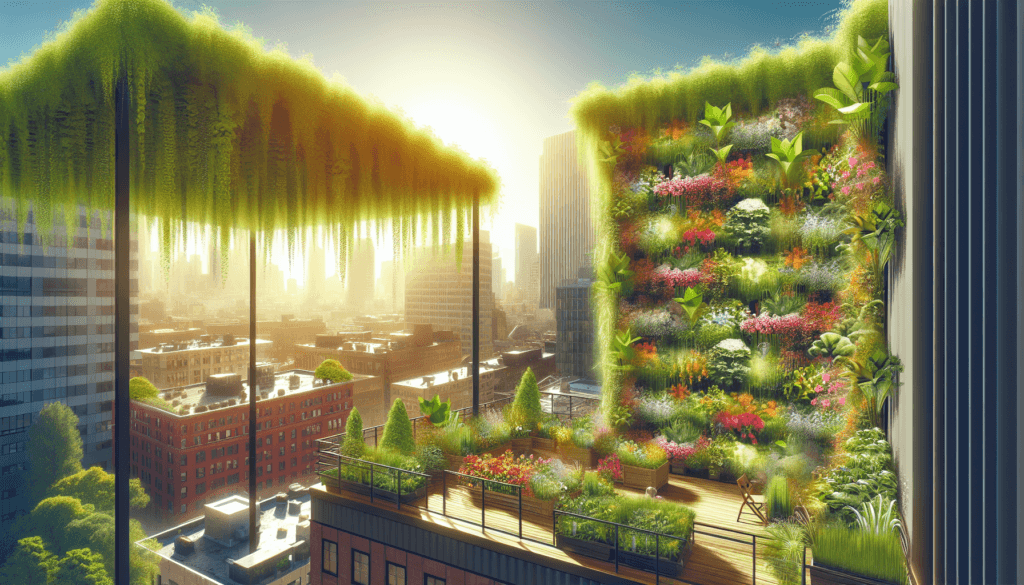Are you an urban dweller looking to add some greenery to your life? Look no further than urban gardening tips for creating a beautiful vertical garden. With limited space in cities, vertical gardens are a clever and space-saving solution for bringing nature indoors. Whether you have a small balcony or a tiny backyard, these tips will help you transform any space into a lush and vibrant garden. From selecting the right plants to maximizing vertical space, this article will guide you through creating a stunning vertical garden that will breathe new life into your urban oasis.
Choosing the Right Plants
When it comes to creating a vertical garden, it’s essential to choose the right plants that will thrive in this unique growing environment. Consider the growing conditions of your space, such as the amount of sunlight it receives and the temperature range. Some plants prefer full sun, while others thrive in partial shade. Additionally, think about the wind exposure and humidity levels in your area, as these factors can also impact plant growth.
Select plants that are known for their ability to grow vertically. Climbing and trailing plants are an excellent choice for vertical gardens, as they naturally have a tendency to reach for the sky. Some popular options include ivy, jasmine, roses, and certain varieties of tomatoes or cucumbers. These plants not only add visual interest but also make efficient use of the available vertical space.
To minimize maintenance efforts, choose plants that require minimal care. Look for varieties that are disease-resistant and have a higher tolerance for drought or heat. Succulents, for example, are a great choice for vertical gardens as they can store water in their leaves, reducing the need for frequent watering. By selecting low-maintenance plants, you can enjoy your vertical garden without spending too much time on upkeep.
Designing Your Vertical Garden
Before diving into building your vertical garden, take the time to carefully plan and design the layout. Start by assessing the available space you have for your garden and consider its dimensions. Vertical gardens can be created on walls, fences, or even in smaller spaces indoors. Understanding the limitations and possibilities of your space will help inform your design decisions.
Once you’ve evaluated the space, determine the style you want for your garden. Are you looking for a sleek and modern design, or do you prefer a more natural and rustic look? This decision will guide the choice of materials, colors, and overall aesthetic of your vertical garden.
Plan the layout of your vertical garden by considering the height and structure of the plants you’ve chosen. Place taller plants towards the back or center of the garden, and shorter plants towards the front. This will ensure that each plant receives adequate sunlight and creates a visually pleasing arrangement.

Building a Sturdy Support Structure
A sturdy support structure is crucial for the success of your vertical garden. When choosing materials, opt for those that are durable and can withstand the elements. Common choices include wooden frames, metal trellises, or even repurposed pallets. Consider the aesthetics of the materials as well, as they will be visible within your garden.
Weight and stability are other important considerations. Ensure that your support structure can bear the weight of the plants when they are fully grown. If using wall-mounted structures, make sure they are securely attached to prevent any accidents or damage. Additionally, providing proper spacing between the plants and the support structure will allow for adequate airflow and prevent overcrowding.
Preparing the Soil
The soil you use for your vertical garden plays a crucial role in the success of your plants. Opt for lightweight and well-draining soil to prevent waterlogging and root rot. Heavy clay soils, for example, can become compacted and hinder proper root growth. Look for soil mixes specifically formulated for container gardens or consider making your own by combining potting soil with organic matter like compost or perlite.
Amending the soil with compost not only improves drainage but also provides additional nutrients for the plants. Organic matter helps retain moisture and promotes healthy root development. Before planting, mix in a generous amount of compost or well-rotted manure into the soil to ensure your plants have access to the essential nutrients they need.
It’s also important to test the pH level of the soil. Most plants prefer a slightly acidic to neutral pH range. Testing kits are readily available at garden centers or can be purchased online. If your soil’s pH is outside the ideal range, you can adjust it by adding amendments like lime to raise the pH or sulfur to lower it.

Planting and Nurturing Your Vertical Garden
Once you’ve prepared the soil, it’s time to plant and nurture your vertical garden. Adequate watering is essential for the health of your plants. Since vertical gardens often have limited soil volume, they can dry out quickly. Monitor the moisture level regularly, and water whenever the top inch of soil feels dry. Consider using a drip irrigation system or self-watering containers to ensure consistent watering.
Applying appropriate fertilizer is also important to provide the necessary nutrients for your plants’ growth. Slow-release fertilizers or organic options like compost tea can be beneficial. Follow the instructions on the fertilizer package and avoid over-application, as excessive fertilizer can lead to nutrient imbalances or burn the plants’ roots.
Monitor your vertical garden for pests and diseases regularly. Aphids, mites, and whiteflies are common pests that can affect vertical gardens. Use natural or organic pest control methods whenever possible to avoid harming beneficial insects. Regularly inspect your plants for any signs of disease and promptly remove any infected foliage to prevent the spread.
Optimizing Sunlight and Shade
Assess the sunlight exposure in your chosen location to optimize the growth of your vertical garden. Some plants thrive in full sun, while others require partial shade. Observe the amount of sun your space receives throughout the day and choose plants accordingly. Leafy greens and herbs, for example, generally prefer partial shade, while flowering plants often require more direct sunlight.
If your space has excessive sunlight or intense heat, utilize shading techniques to protect your plants. Install shade cloth or use larger plants to create natural shade for those that are more sensitive to direct sunlight. This will help prevent sunburn and reduce evaporation from the soil, keeping your plants healthier and more hydrated.
Consider rotating your plants occasionally to maximize the sunlight they receive. As your vertical garden grows, some plants may become shaded by taller ones. By rotating their positions every few weeks, you can ensure each plant gets equal access to sunlight, promoting balanced growth.

Maintaining a Well-Groomed Garden
To keep your vertical garden looking its best, regular maintenance is necessary. Regularly prune and trim plants to maintain their shape and encourage bushier growth. This is particularly important for climbing plants that can become tangled or overtake other plants if left unattended. Use clean and sharp pruning tools to prevent the spread of disease.
Remove dead or diseased plants as soon as you notice them. Dead plants not only detract from the overall aesthetics but can also attract pests and diseases. By promptly removing them, you prevent the spread of any potential issues and create space for new plants to thrive.
Mulching the soil is another essential maintenance practice for vertical gardens. This helps retain moisture, suppresses weed growth, and adds organic matter to the soil. Apply a layer of organic mulch like wood chips or straw around the base of your plants, taking care not to bury the stems or leaves.
Creating a Beautiful Vertical Garden Display
To create a visually stunning vertical garden display, consider specific design elements. Start by choosing a color scheme that complements your space and personal preferences. Monochromatic themes can create a soothing and elegant atmosphere, while vibrant and contrasting colors add excitement and visual interest.
Incorporate hanging baskets and trellises into your vertical garden design. Hanging baskets can add depth and variety to your display, allowing you to include plants that don’t naturally cling to walls or trellises. Trellises, on the other hand, provide a vertical structure for climbing plants, creating a lush and dynamic aesthetic.
Don’t forget to add decorative elements and accessories to enhance the overall look of your vertical garden. Install wall-mounted planters or add ornamental pieces like colorful ceramic pots or decorative bird feeders. These additions can elevate the aesthetics and make your vertical garden a focal point of your space.

Tips for Small Spaces
If you have limited space for your vertical garden, there are several tips you can follow to maximize its potential. Utilize vertical space by mounting planters on walls, fences, or even hanging them from the ceiling. This allows you to grow plants without taking up valuable floor space.
Consider compact plant varieties that are specifically bred for small gardens or containers. These varieties often have smaller foliage or stay more compact, making them ideal for vertical gardens. Look for dwarf varieties of flowers, herbs, and vegetables that can be trained to grow upwards.
Hanging planters and vertical planters are also useful for small spaces. Hanging planters can be suspended from hooks or brackets, creating a cascading effect and adding visual interest. Vertical planters, such as pocket planters or modular systems, allow you to grow multiple plants in a limited area.
Watering Techniques for Vertical Gardens
Efficient watering is crucial for the success of your vertical garden, especially if you live in an urban environment with limited water resources. Utilizing drip irrigation systems is an excellent way to ensure your plants receive adequate moisture while minimizing water waste. Drip systems deliver water directly to the plant’s roots, reducing evaporation and preventing excess water from pooling on leaves.
Implementing self-watering containers can also be beneficial for vertical gardens. These containers have reservoirs that hold water, allowing the plants to draw moisture as needed. Self-watering containers are particularly useful in hot and dry climates or if you have to be away from your garden for an extended period.
Avoid overwatering your vertical garden, as excess moisture can lead to root rot and other plant diseases. Ensure proper drainage by using containers with drainage holes and allowing excess water to escape. Proper drainage helps maintain oxygen levels in the soil and prevents waterlogged conditions.
In conclusion, creating a beautiful vertical garden in an urban environment is a rewarding and achievable endeavor. By carefully selecting the right plants, designing the layout, building a sturdy support structure, preparing the soil, and following proper watering techniques, you can create a thriving and visually stunning vertical garden display. Regular maintenance, such as pruning and grooming the plants, and incorporating design elements like color schemes, hanging baskets, and decorative accessories, can further enhance the beauty of your vertical garden. With these tips, even if you have limited space, you can enjoy the benefits of gardening and bring nature into your urban surroundings. So, get started on your vertical garden project and watch it transform into a lush and vibrant oasis!


